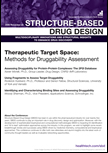2013 Archived Content
 CONFERENCE SERIES: Drug Targets
CONFERENCE SERIES: Drug Targets
Recorded at: Structure-Based Drug Design
 Digital Course: Therapeutic Target Space: Methods for Druggability Assessment
Digital Course: Therapeutic Target Space: Methods for Druggability Assessment
June 23, 2010
About the Conference:
Structure-Based Drug Design (SBDD) has been in use within the pharmaceutical industry for over twenty-five years. SBDD continues to play an important role in drug discovery, design and optimization. Moreover, with the development of sophisticated biophysical and computational methodologies SBDD is impacting hit identification and ‘hit to lead’ optimization approaches across the industry. In this program, we wish to highlight some recent breakthrough stories and successes using SBDD driven by medicinal chemistry, computational and biophysical approaches. This conference continues to offer both new attendees and alumni insights into the latest work of community thought leaders as well as invaluable networking opportunities.
Assessing Druggability for Protein-Protein Complexes: The 2P2I Database
 Xavier Morelli, Ph.D., Group Leader, Drug Design, CNRS/ IMR Laboratory
Xavier Morelli, Ph.D., Group Leader, Drug Design, CNRS/ IMR Laboratory
Our group has developed innovating protocols targeting PPI inhibitions, such as the 2P2I approach (Betzi et al., PNAS 2007). However, the main actual impediment in further PPI inhibitors development relates on i) the absence of dedicated chemical databases and ii) the identification of druggable/targetable complexes. This conference will present: 1) A general introduction focusing on the biophysical parameters related to PPI’s 2) Our dedicated protein-protein database, 2P2IDB 3) Original Druggability parameters that could permit to differentiate druggable from non-druggable complexes.
Biography:
Group Leader at CNRS, Marseille France: 9 persons (3 permanent researchers, 1 technician, 1 Postdoctorate and 4 PhD students) involved in the “Interactions, Dynamics and Drug Design (ID3)” group.
PhD from University of Paris XI (Orsay), January 2000 in Biological Cristallography and NMR.
Postdoctorate at Harvard Medical School from January 2000 to September 2002.
30 Publications (25 published, 1 in press, 4 submitted): Developer of the “Soft-Restrained Docking Approach” (coupling protein-protein docking with NMR data, published in JBC 2000) and of the “2P2I Approach” (coupling in silico screening with NMR data, published in PNAS 2007).
2 world patents (peptide and small compounds directed against the HIV-1 Nef protein).
More than hundred hours of teaching at the University.
Director of 4 Ph.D. thesis and numerous undergraduate students.
Invited to 12 international conferences since 2005.
Consulting for the « Agence Nationale pour la Recherche (ANR) » since 2006
Using Fragments to Assess Target Druggability
.jpg?n=6621) Roderick Hubbard, Ph.D., Professor and Senior Fellow, Structural Sciences, University of York and Vernalis
Roderick Hubbard, Ph.D., Professor and Senior Fellow, Structural Sciences, University of York and Vernalis
We have used experimental fragment screening against a range of targets (from kinases to protein-protein interaction targets). The hit rate does not always correlate with computational assessment of druggability, but can indicate where there are other issues with finding robust lead compounds against a Target. The experimental screen can be contrasted with computational assessment of structure through fragment docking approaches. This presentation will include further analyses of how target druggability can be assessed and comparison of experimental and computational approaches. The audience will gain a fuller understanding of the relationship between target structure, fragment screening hit rates and target druggability.
Biography: Rod Hubbard has spent all his academic career at the University of York. During the 1980s, he developed and applied methods in molecular graphics and modelling. Through the 1990's he helped to build and directed the York Structural Biology Laboratory, studying the structure and function of many classes of proteins, some of which were important therapeutic targets. In 2001, he took the opportunity to establish and lead protein structure based discovery at the company that is now called Vernalis, where he has focussed on the integration of fragment and structure based methods with medicinal chemistry. He is also Chairman of various BBSRC committees and acts as a consultant to a number of pharmaceutical and biotechnology companies.
Identifying and Characterizing Binding Sites and Assessing Druggability
.jpg?n=8203) Woody Sherman, Ph.D., Vice President, Applications Science, Schrodinger, Inc.
Woody Sherman, Ph.D., Vice President, Applications Science, Schrodinger, Inc.
Identification and characterization of binding sites is key in the process of structure-based drug design. We present a method for identifying and analyzing binding sites, which can also be used to predict target druggability. In a large-scale validation, we correctly identify the known binding site as the top-ranked site in 86% of the cases, with best results (>98%) coming for sites that bind ligands with subnanomolar affinity. In addition, a modified version of the score employed for binding-site identification allows for the accurate classification of the druggability of proteins as measured by their ability to bind passively absorbed small molecules tightly.
Biography: Woody Sherman is the Vice President of Applications Science at Schrodinger. He received his Ph.D. from MIT where he developed a novel method for optimizing ligand binding specificity across a panel of targets. While in graduate school he completed an internship at Biogen where he helped develop novel methods to enhance antibody affinity that resulted in a patent and publication. He has authored papers on many diverse aspects of computer-aided drug design, including induced-fit docking, binding specificity, water thermodynamics, antibody design, fragment docking, cheminformatics, and hybrid ligand/structure-based methods. He is also co-author on two patents.
About this Product:
3 Presentations
Over 127 slides
109 minutes
Single Copy - $345.00
Site License - $1,380.00